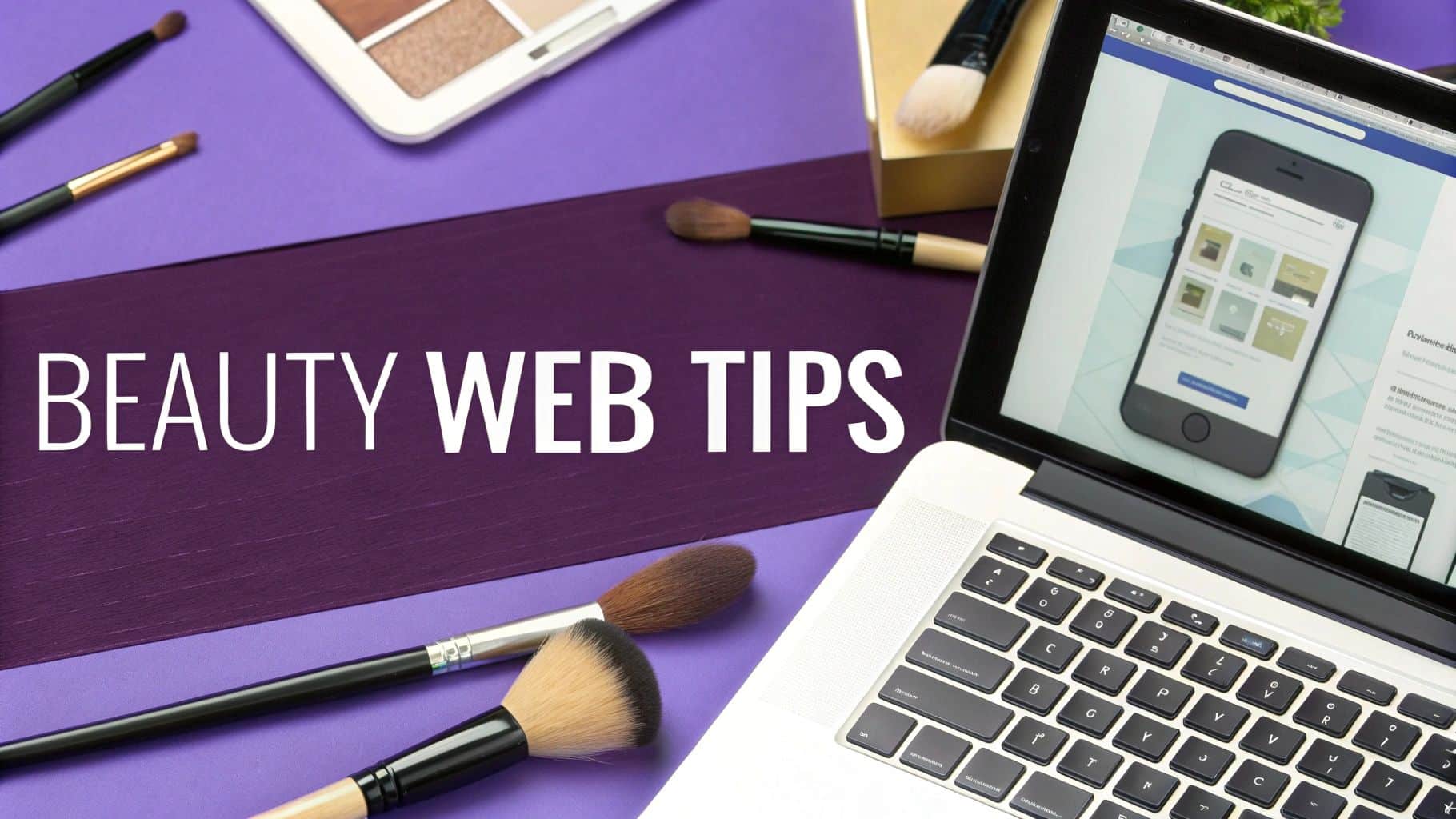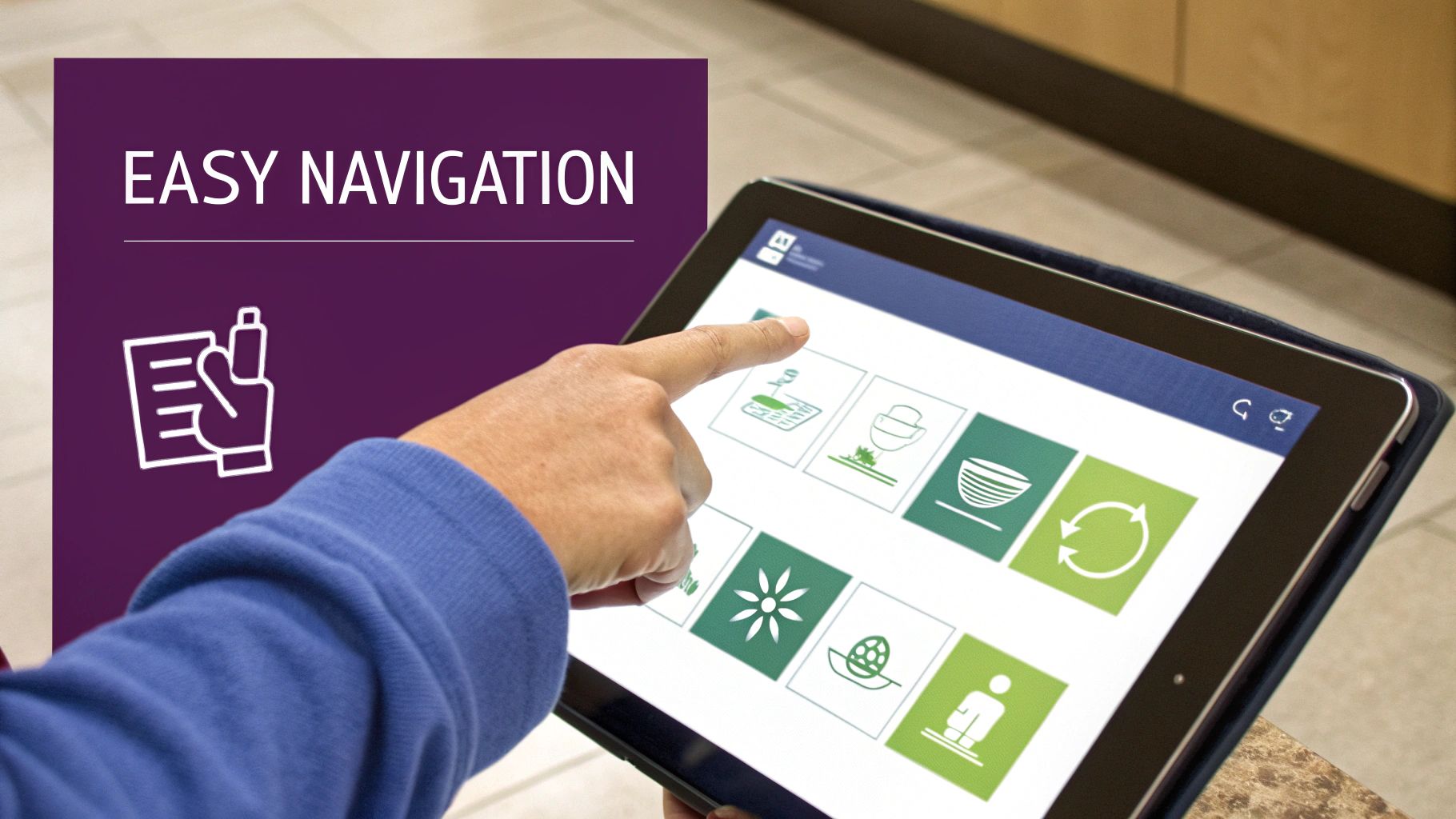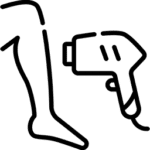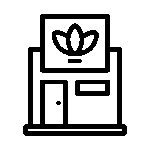10 Website Design Best Practices for Beauty Pros in 2025

In the competitive beauty industry, your website is often the first impression a potential client has of your brand. It is more than just a digital brochure; it is your 24/7 receptionist, your most powerful marketing tool, and a direct reflection of the quality and care you provide. Getting it right can mean the difference between a fully booked schedule and missed opportunities. However, navigating the world of web design can feel overwhelming for busy professionals.
That’s why we have distilled the essentials into this comprehensive guide. We focus on actionable website design best practices tailored specifically for beauty professionals like you, from salon owners and spa managers to estheticians and lash artists. Forget generic advice and confusing jargon. Instead, this listicle provides 10 clear, easy-to-follow strategies designed for immediate implementation.
Each point will give you practical steps to enhance your site's performance, from securing more online bookings to ensuring your brand shines online. You will learn how to create a beautiful, functional, and client-attracting digital presence that works as hard as you do, transforming your website from a simple landing page into a core business asset that drives growth and builds lasting client relationships.
1. Mobile-First Responsive Design: Captivate Clients On The Go
In the beauty industry, your clients are constantly on the move. They might discover your salon on Instagram during their commute or book their next facial from their couch. This is why a mobile-first approach to your website is non-negotiable. It means you design for a phone screen first, then adapt that design for tablets and desktops.
This ensures your most important information—your services, "Book Now" button, and contact details—is clear and easy to use on a phone. For a client trying to book a last-minute appointment, a confusing mobile site is a deal-breaker. Following this practice guarantees a smooth experience for every visitor, no matter their device.
Actionable Steps for Implementation:
- Prioritize Core Content: For the mobile view, focus only on the essentials. Your "Book Now" button, a simple services menu, your address, and phone number must be easy to find. Everything else is secondary.
- Test on Real Devices: Don't just trust your website builder's preview. Open your site on your own iPhone and an Android phone. Can you easily tap the buttons? Is the text readable without zooming? Does it load quickly?
- Embrace Vertical Scrolling: Mobile users are used to scrolling. Design your pages with a simple, top-to-bottom flow. Use your best photos and short text sections to guide visitors down the page towards your booking button.
To fully grasp the advantages of creating a seamless experience across all devices, explore the myriad benefits of responsive website design. This approach not only caters to your clients' browsing habits but also significantly improves your search engine ranking, making it easier for new clients to find you.
2. Fast Loading Speed: Secure Bookings Before They Bounce
In the digital world, patience is rare. A potential client is just one slow page away from leaving and booking with your competitor. A fast website isn't just a technical detail; it's essential for good customer service. For a salon, every second a user waits for your booking page to load increases the chance they'll give up.

This fundamental website design best practice means making sure your site loads in under three seconds. Google also ranks faster websites higher in search results. By making your site faster, you keep potential clients engaged and make it easier for new ones to find you online.
Actionable Steps for Implementation:
- Compress Your Visuals: Your beautiful portfolio photos are often the biggest cause of slow speeds. Use a free tool like TinyPNG or a plugin on your website to reduce image file sizes without losing visual quality. Ask your developer about modern formats like WebP.
- Benchmark and Monitor: You can't fix what you don't measure. Use the free Google PageSpeed Insights tool to check your site's speed. It will give you a score from 0-100 and a to-do list of fixes for you or your web developer.
- Leverage Caching: Caching saves a copy of your website for visitors, so it loads instantly for them the next time they visit. Most website platforms (like Squarespace or Shopify) and web hosts have a caching option you can turn on with one click.
By optimizing your website's performance, you create a frictionless path from discovery to booking. This ensures that a client's excitement to book a service with you isn't derailed by frustrating technical delays, directly impacting your bottom line and client satisfaction.
3. Intuitive Navigation and Information Architecture: Guide Clients Effortlessly
Imagine a client walking into your salon with no one at the front desk and no signs pointing to treatment rooms. They would get frustrated and leave. Your website's navigation is that virtual front desk. If it's confusing, clients will leave and book with a competitor whose site is easier to use.

Information architecture is simply organizing your website's content logically so people can find what they need quickly. For a busy esthetician, good navigation means fewer phone calls from confused clients and more appointments booked automatically, because service details, prices, and booking options are easy to find.
Actionable Steps for Implementation:
- Simplify Your Main Menu: Your main navigation bar should be clean and simple. Use 4-6 clear labels like "Services," "About Us," "Gallery," "Contact," and a highly visible "Book Now" button. Avoid confusing or overly creative terms.
- Group Services Logically: If you have a long service list, group them into categories. For example, a spa menu should be organized under "Facials," "Massage," and "Nail Services." A client looking for a "deep tissue massage" will know exactly where to click.
- Ensure a Clear Path to Booking: Every page on your site should point towards booking. A page describing your facials must have a button to "Book a Facial." Keep your "Book Now" button a consistent color and in the same spot on every page (usually the top right).
To learn more about creating a user-friendly site map and menu structure, you can explore the foundational principles in Steve Krug's renowned book, Don't Make Me Think. Applying these concepts will ensure your website is not just beautiful, but also a highly effective tool for converting visitors into loyal clients.
4. Accessibility and Inclusive Design: Welcome Every Client
An exceptional beauty experience should be for everyone, and your website must reflect that. Website accessibility means designing your site so people with disabilities (like vision or hearing loss) can use it easily. This isn't just about following rules; it's about showing that your brand is welcoming to all potential clients.

This means a client using a screen reader can understand your services just as well as anyone else, or someone who can't use a mouse can still book an appointment. By designing for everyone, you expand your client base and make your site better and more user-friendly for all visitors.
Actionable Steps for Implementation:
- Prioritize Text Readability: Use a high-contrast color scheme for your text and background (e.g., dark gray text on a white background). Use simple, clear fonts and never place important text over a busy photo, which is hard for many people to read.
- Add Alt Text to Images: Alternative text (alt text) is a short, written description of an image. Screen readers read this text aloud to users with visual impairments. Write a simple description for every photo, like "Blonde balayage on long wavy hair" or "Interior of modern, clean salon."
- Ensure Keyboard Navigation: Check if you can navigate your entire website using only the 'Tab' key on your keyboard. You should be able to jump from link to button to form field. This is crucial for users with motor disabilities who cannot use a mouse.
For a thorough approach to inclusivity, consult a comprehensive website accessibility checklist to ensure your digital space is welcoming to all. Embracing these standards demonstrates a deep level of customer care that sets your beauty business apart and builds lasting trust.
5. Clean, Minimalist Visual Design: Let Your Services Shine
In the visual world of beauty, it's easy to overdo it with colors and fonts on your website. However, a clean, simple design is often more effective. This isn't about being boring; it's about using simplicity to your advantage. By removing clutter and using "white space" (empty areas on the page), you create a high-end feel that puts the focus on your work and your "Book Now" button.
A minimalist design makes your brand feel more professional and luxurious. When a client lands on a calm, uncluttered page, they can easily find your services and gallery without distraction. This sophisticated experience helps turn browsers into booked clients because it communicates confidence—your work speaks for itself.
Actionable Steps for Implementation:
- Embrace Strategic White Space: Use empty space to make your content easier to read. Add generous spacing around your photos, paragraphs, and buttons. This creates breathing room and makes your site feel more premium and organized.
- Focus on Typography: With a simple design, your fonts are very important. Choose one or two clean, easy-to-read fonts that match your brand. Use bold or larger sizes for headings to guide the eye without adding visual clutter.
- Be Ruthless with Elements: Look at every icon, line, and word on your page. Ask yourself: "Does this help my client book an appointment?" If not, consider removing it. The goal is to make the path to booking as clear as possible.
To see how minimalism can create a powerful brand identity, look no further than the iconic Apple design philosophy. Their approach demonstrates how focusing on essential elements creates a sense of luxury and unparalleled user focus, a principle that translates perfectly to a high-end salon or spa website.
6. User Experience (UX) Testing and Optimization: Refine and Perfect the Client Journey
Launching your website isn't the finish line. It's the starting point. Just like you watch how clients move through your physical salon, you need to observe how they use your website. User Experience (UX) testing is the process of watching real people use your site to find what's confusing or broken.
This takes the guesswork out of improving your site. You may think your services page is clear, but testing might show that clients can't find your prices. Consistently testing and improving your site ensures it works for your clients, which means fewer lost bookings and a reputation for being easy to work with.
Actionable Steps for Implementation:
- Start with Simple Observation: Ask a friend or a loyal client to complete a task on your website, like "Try to book a 60-minute facial for next Tuesday." Watch them do it without helping. Note where they get stuck or seem confused. Their fresh eyes will reveal problems you missed.
- Use Heatmap Tools: Free tools like Hotjar can create "heatmaps" of your website pages. These maps visually show you where people are clicking, how far down they scroll, and what parts they ignore. This helps you put important buttons in the best spots.
- Analyze Your Booking Funnel: Check your booking software's analytics (or Google Analytics) to see the drop-off rate. How many people start booking versus how many finish? If many people abandon the process, your form might be too long or a step might be confusing.
To dive deeper into making your website not just beautiful but also effective, consider exploring resources on usability testing for small businesses. This will equip you with the knowledge to turn user feedback into higher conversion rates and a more profitable online presence.
7. Search Engine Optimization (SEO) Best Practices: Be Discoverable on Google
A beautiful website is useless if no one can find it. Search Engine Optimization (SEO) is how you make sure your site shows up on Google when potential clients are searching. When someone in your area searches "best lash extensions" or "salon near me," a well-optimized site will appear at the top of the results.
Good SEO is built into your website from the very beginning. It's not just something you do later. It affects everything from your page titles to your loading speed. For a salon, showing up on the first page of Google means a constant flow of new clients who are actively looking for your services.
Actionable Steps for Implementation:
- Focus on Local Intent: Make sure your website text includes your city and neighborhood. Instead of a page titled "Services," name it "Haircuts and Color in [Your City]." This helps you show up in local searches. Your homepage title should be something like "[Your Salon Name]: Premier Salon in [Your City]."
- Optimize for Core Web Vitals: Google rewards websites that provide a good user experience. This means your site needs to load fast and be easy to interact with on mobile. Use Google's PageSpeed Insights tool to check your site and follow its recommendations.
- Build an Internal Linking Web: Link your pages to each other. On your homepage, when you mention "facials," make that word a link to your main facials service page. This helps Google understand what your site is about and helps users find information more easily.
To truly harness the power of search and attract more clients online, it's essential to build a solid foundation. You can dive deeper and learn more about beauty business SEO strategies to turn your website into a powerful client-acquisition machine. This approach will give you a significant competitive edge, making it easier for new clients to discover and book with you.
8. Security and Trust Indicators: Build Confidence and Protect Client Data
When a client books online, they're trusting you with their personal information. Building that trust on your website is essential. Security and trust indicators are the things that show users your site is safe, like the padlock icon in the browser bar (from an SSL certificate) or a clear privacy policy.
For a beauty business, showing this care online reinforces your brand's professionalism. A client who feels their information is safe is more likely to book an appointment or buy a gift card. This isn't just a technical task; it's a key part of building client confidence before they even walk in your door.
Actionable Steps for Implementation:
- Install an SSL Certificate: This is a must-have. An SSL certificate encrypts the connection to your site, gives you the "https://" address, and displays a padlock icon in the browser. Most website builders and hosts offer free SSL certificates. Ask your provider to enable it.
- Display Trust Badges: On your booking or checkout pages, show the logos of the payment methods you accept (like Visa, Mastercard, PayPal). If you use a secure booking software, you can often add their security badge. These logos visually reassure clients.
- Create a Clear Privacy Policy: Have a page on your site called "Privacy Policy" that explains in simple terms what client data you collect (e.g., name, email for appointments) and that you will not sell it. This transparency builds significant trust.
To see how a major payment processor communicates security to its users, you can look at the extensive resources provided on the PayPal Security Center. While your salon's needs are different, their approach to clear communication and user assurance offers valuable lessons for any business handling sensitive information.
9. Conversion Rate Optimization (CRO): Turn Visitors into Booked Clients
A beautiful website is great, but its main purpose is to get you more business. Conversion Rate Optimization (CRO) is the process of making small changes to your website to get more visitors to take action—specifically, to book an appointment. Instead of just trying to get more website traffic, CRO helps you get more value from the traffic you already have.
For a salon, a "conversion" is a booked appointment. By changing things like the color of your booking button or the wording on your service pages, you can encourage more visitors to click "Book Now." This turns your website from a passive online flyer into an active tool that generates clients 24/7.
Actionable Steps for Implementation:
- Make Your Call-to-Action (CTA) Pop: Your "Book Now" button should be the most noticeable thing on the page. Use a bright, contrasting color that stands out from your other brand colors. Try using urgent, action-focused text like "Book My Appointment Now" instead of a simple "Book."
- Simplify Your Booking Form: Every question you ask in your booking form is a reason for someone to give up. Only ask for the absolute essentials: name, email, and phone number. You can gather more details when they arrive for their appointment.
- Add Social Proof at Key Moments: Place your best client reviews or star ratings right next to your service descriptions or booking button. When a potential client sees that other people loved their experience, it builds the trust needed to make a booking.
To see how experts build high-performing pages, look at the resources from platforms like Unbounce. Their focus on landing page performance provides valuable lessons for optimizing any page on your beauty website to drive more bookings.
10. Strategic Content and Clear Information Hierarchy: Guide Clients to Book
A stunning website is ineffective if clients can't find what they need. A solid content strategy and clear information hierarchy solve this by intentionally organizing your website's information. This isn't just about what you say, but where and how you say it, guiding visitors logically from their first impression to the final booking confirmation. It ensures every piece of content serves a purpose, answering client questions and supporting your business goals.
For your salon or spa, this means a potential client should never have to hunt for your service menu, pricing, or booking link. This strategic organization builds trust and professionalism, showing clients you value their time. Implementing this crucial website design best practice transforms your site from a simple online brochure into a powerful, automated booking assistant that works for you 24/7, making it a cornerstone of effective website design for salons.
Actionable Steps for Implementation:
- Plan Your User's Journey: Think like a new client. What's the first thing they want to know? Your services. The second? Your prices. The third? How to book. Your main menu should follow this path: Home, Services, Pricing, Book Now, Contact.
- Prioritize with an Inverted Pyramid: On every page, put the most important information first. For a service page, this means the service name, a short description, the price, and a "Book This Service" button should all be visible at the top before you go into more detail.
- Use Clear Headings and Short Paragraphs: Break up walls of text. Use descriptive headings ("Our Signature Facials," "Lash Extension Packages"). Keep paragraphs short (2-3 sentences) and use bullet points for lists like service benefits or aftercare instructions.
To truly make your message clear and impactful, you must ensure your text is as well-planned as your layout. Learning to master writing copy for websites is essential for boosting engagement and converting visitors into loyal clients.
10 Key Website Design Best Practices Comparison
| Item | Implementation Complexity 🔄 | Resource Requirements ⚡ | Expected Outcomes 📊 | Ideal Use Cases 💡 | Key Advantages ⭐ |
|---|---|---|---|---|---|
| Mobile-First Responsive Design | Medium – requires planning & testing | Moderate – designers & developers | Improved UX across devices, better SEO | Websites targeting mobile users & multiple devices | Future-proofs sites, enhances SEO, better mobile experience |
| Fast Loading Speed & Performance Optimization | High – ongoing optimization needed | High – specialized tools & monitoring | Faster load times, improved rankings, conversions | Sites requiring speed & performance focus | Lower bounce rates, cost savings, better UX |
| Intuitive Navigation & Information Architecture | Medium – needs user research & updates | Moderate – UX researchers & designers | Easier content discovery, better engagement & SEO | Content-rich or complex sites | Reduces confusion, improves task completion |
| Accessibility and Inclusive Design | Medium to High – requires testing & compliance | Moderate – testers & developers | Broad audience reach, legal compliance | Public sector, ecommerce, sites targeting diverse users | Expands audience, SEO boost, social responsibility |
| Clean, Minimalist Visual Design | Low to Medium – focused design effort | Low to Moderate – designers only | Better readability, faster loads, timeless look | Branding-focused or content-centric sites | Simplicity, faster loading, timeless aesthetic |
| User Experience (UX) Testing & Optimization | High – continuous testing effort | High – research tools & user involvement | Data-driven improvements, higher conversion rates | Any site seeking ongoing UX improvement | Reduces assumptions, improves conversion |
| SEO Best Practices | Medium – ongoing updates required | Moderate – SEO specialists & content creators | Increased organic traffic and better rankings | Sites relying on search traffic | Long-term traffic growth, cost-effective marketing |
| Security and Trust Indicators | Medium – regular maintenance needed | Moderate – security expertise required | Builds trust, protects data, improves SEO | E-commerce, banking, sensitive data sites | User trust, SEO benefits, legal compliance |
| Conversion Rate Optimization (CRO) | Medium to High – requires continuous testing | Moderate to High – analytics & marketing teams | Increased conversions and revenue | Sales-focused or lead generation sites | Maximizes traffic ROI, user behavior insights |
| Content Strategy and Information Hierarchy | Medium – ongoing content planning | Moderate – content creators & strategists | Improved engagement, SEO, brand authority | Content-heavy & marketing-driven websites | Guides user actions, builds trust |
Your Beautiful Website Awaits
Navigating the world of website design can feel as intricate as performing a perfect balayage or sculpting a flawless brow arch. However, as we've explored, mastering the core principles of digital craftsmanship is not about becoming a coder overnight. It’s about understanding what transforms a simple online brochure into a dynamic, client-attracting powerhouse that works for your beauty business 24/7.
The journey we've taken through these ten essential website design best practices provides a comprehensive blueprint for success. From the non-negotiable foundation of a mobile-first, responsive design that meets clients on their phones, to the critical need for lightning-fast loading speeds that prevent bounce rates, each element plays a vital role. We've seen how intuitive navigation and a clean, minimalist aesthetic create a serene and user-friendly environment, mirroring the calming experience you offer in your salon or spa.
From Blueprint to Blooming Business
Think of your website as your digital front desk, your online portfolio, and your most dedicated receptionist all rolled into one. The true value of implementing these strategies lies in building a seamless and trustworthy client journey.
- Build Trust Instantly: By prioritizing security (SSL certificates), showcasing social proof (reviews and testimonials), and ensuring accessibility for all users, you immediately establish credibility. A visitor who trusts your website is one step closer to trusting you with their business.
- Guide, Don't Confuse: A well-defined content hierarchy and clear calls-to-action (CTAs) are your digital wayfinding signs. They guide potential clients effortlessly from learning about your unique lash extension techniques to clicking that "Book Now" button, eliminating friction and boosting your conversion rates.
- Get Found by the Right Clients: Integrating fundamental SEO practices isn't just a technical task; it's a strategic business move. It ensures that when a local client searches for "best facial near me" or "expert hair colorist," your beautifully designed website appears as the top solution.
Applying these website design best practices is the most direct way to translate your real-world artistry and professionalism into the digital realm. It ensures your online presence accurately reflects the high standard of care and expertise you provide in person. Your website should not be a source of stress; it should be a source of new clients, consistently and reliably. Take these actionable principles, apply them one by one, and build a digital storefront that not only looks stunning but also drives tangible growth for your business.
Ready to build a stunning website without the technical headache? gohappybeauty is an all-in-one platform designed specifically for beauty professionals, with all these best practices built right in. Get a beautiful, high-converting, and SEO-optimized website that lets you focus on your craft by visiting gohappybeauty today.
Grow your beauty business
Our focus is, and always will be, helping you improve your online presence and generate more business from your website. That is what we do, for you.

